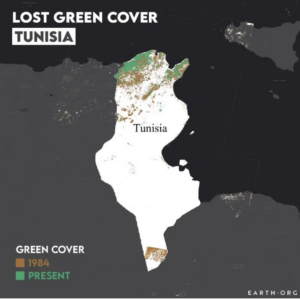A Siege of Salt and Sand-Review
October 2, 2023
The film A Siege of Salt and Sea is an informative piece demonstrating how the combination of geographical location and climate change impacts the traditions and livelihood of Tunisian citizens.

https://u4d2z7k9.rocketcdn.me/wp-content/uploads/2021/08/lost-green-cover-Tunisia-1.jpg.webpmoney.
By interviewing citizens and scientists instead of politicians or authorities, the filmmakers captured how desertification and rising sea levels impact daily life. The citizens spoke of their worries for the future, their children, and how climate change affects how people live and spend money. Climate change has forced many Tunisians to choose between supporting their families or fighting the impact of climate change. In addition, citizens experience how insect infestations affect daily lives, even when politicians may not be inclined to elaborate on such issues.
Many interviewees spoke of their childhood and the rapid change that has occurred in the last decades in their hometowns and regions.
The film’s structure also demonstrates that much of the pressure to mitigate the effects of climate change is placed upon affected citizens when policy is a preferable way to tackle the issue. Multiple persons mentioned their dissatisfaction with how authorities handled the climate crisis.
The filmmakers also included the Arab Spring and how they have become one of the first nations to include climate change in their constitutions. It demonstrates how the people of Tunisia value the environment and a sustainable future if policy allows them to access such a future.
October 17th, 2023 at 3:15 am
Did this documentary change how you understood or thought about any other course materials or discussions?
October 17th, 2023 at 5:43 am
Absolutely. The documentary helped me understand the socioeconomic pressures of climate change in the region, its effect on populations, like urban migration, and the cultural impact it causes. Such issues may explain some countries’ hesitancy to invest in agricultural sectors.
In addition, I was also able to understand how climate change impacts regions that are already exceptionally water-scarce. Combining the two makes it difficult for citizens to financially or carry out day-to-day tasks. For example, desertification, making it so that citizens must consistently uncover their houses from the sand has a significant impact on daily lives. In the future, I hope to see more about regional efforts to halt climate change and see what strategies are or are not successful. I also wonder if authoritarian regimes in the region are concerned with climate change and its effects or if they use their resources on other matters. As for countries like Turkey, I wonder what role they play as a country with more water resources and how that affects regional relationships.